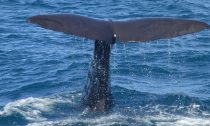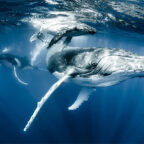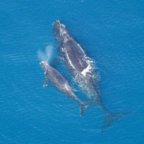
The most convenient place for a dead whale to wash up is somewhere that can be reached with large construction equipment. But when a 12-year-old right whale died in 2005, gruesomely tangled in fishing rope, she came ashore on a remote part of a barrier island off the Virginia coast.
The necropsy team had to take a boat out, then hike to the carcass. They couldn’t carry much back with them for analysis, so the team’s leader, the Woods Hole Oceanographic Institution biologist Michael Moore, used a knife to cut off the largest baleen plate he could. Then he lugged the seven-foot-long plate by hand back across the island.
Baleen plates often fall out soon after a whale dies and are lost, so this one “was a very major get,” says Nadine Lysiak, a biologist at the University of Massachusetts at Boston. She was Moore’s graduate student at the time he brought back the rare find, so she had the opportunity to study it.
In the years since, she has made the most of the endangered whale’s death by turning that tissue into a forensic tool. She’s learned more about the events leading up to the animal’s demise, and worked toward developing a method that can someday reveal the sometimes mysterious circumstances that kill other whales.
Baleen is sort of like teeth: It grows down from the upper jaws of certain whale species, and its fringes filter the whales’ tiny food from the ocean water. But in other ways, baleen is more like hair or fingernails: It grows continuously throughout a whale’s life, and is made of keratin. As new baleen emerges, the oldest baleen wears away. In this way, the molecules in a whale’s baleen become a record of what was happening in its body.
Lysiak drilled a dotted line of samples down the length of the baleen plate from the 12-year-old whale’s necropsy. These samples represented the last eight years of the animal’s life. Researchers already knew a lot about what had happened during those years. There are few enough North Atlantic right whales alive—about 450—that scientists track all of them individually. Lysiak’s whale was called 2301. She was born in 1993 and gave birth in 2002.
Researchers saw her throughout 2003 swimming with her calf. In September 2004, she was spotted near Nova Scotia dragging a mass of fishing rope. Along with boat strikes, this kind of entanglement is one of the main killers of right whales. Researchers intercepted 2301 later that month and tried to cut the rope off, but failed as the whale rolled and ducked away. Six months later, she was dead.
Lysiak began using the baleen samples to add detail to 2301’s biography. First, she looked at non-decaying forms of carbon and nitrogen. Whales, humans, and all other animals get these molecules from food, so ecologists can use this literal you-are-what-you-eat rule to analyze the molecules in an animal’s body for the signature of what—and where—it’s been eating.
Lysiak saw that the whale’s carbon and nitrogen values oscillated over the course of each year, reflecting her annual migration and the plankton she ate in different parts of the ocean. This pattern matched what researchers had seen in other whales. It also let Lysiak map 2301’s whole baleen plate onto a year-by-year timeline.
Later, Lysiak added to the chronology by studying a suite of hormones, including the female reproductive hormones progesterone and estradiol, as well as the stress hormones cortisol and corticosterone. The birth of the whale’s calf in 2002 corresponded to a long peak in progesterone, Lysiak and her co-authors saw.
They thought they’d also find written in the whale’s stress hormones the story of her run-in with rope. “Obviously we expected that the fishing-gear entanglement would be a major source of stress,” Lysiak says. But although 2301’s cortisol—the main stress hormone in most mammals—was elevated at the end of her life, it was much higher while she was pregnant. Lysiak and her co-authors aren’t sure how to explain this finding.
It’s possible that extreme, long-term stress overloads the animal’s system and dampens the hormone response, Lysiak says. Or corticosterone—which did peak during the entanglement of 2301—might be a better marker for stress in whale baleen.
Whale researchers had looked at long-term patterns in all these hormones before, but Lysiak and her co-authors added one new piece to the whale’s biography: thyroid hormones, which control an animal’s metabolism. The scientists guessed that with fishing rope gumming up her baleen and slowing down her swimming, the whale would have had a hard time eating enough.
And at the end of the whale’s life, Lysiak and her co-authors did indeed see a clear signal: a thyroid-hormone spike starting in the summer of 2004, representing a time when the whale may have gone hungry. This suggested the whale had gotten tangled up about three months before researchers first spotted her dragging the rope.
Measuring hormones in baleen offers “another window into whale physiology,” says Rosalind Rolland, a scientist at the New England Aquarium who focuses on whale health. The other tools for studying a whale’s hormones—in its feces, blubber, or the spray from its blowhole—only reflect one point in time, so looking at the baleen can tell a longer story.
But, Rolland adds, baleen likely grows at different rates throughout a whale’s life, influenced by factors such as fasting or pregnancy. Without knowing these rates, using the baleen to pin down specific dates in a whale’s timeline gives you “a broad estimate, at best,” she says.
In her work on 2301, Lysiak had to assume the whale’s baleen grew at a constant rate during each year. The results from the carbon and nitrogen analysis suggest her timeline is accurate to within a month or so, Lysiak says. She’s now doing other studies on how baleen growth varies over time.
As hard-won as that first baleen plate was, the high number of right whale deaths lately means more carcasses have been available. The species is in crisis—which makes Lysiak’s research both easier and more urgent.
She’s hoping to develop her method of analysis into a true forensic tool that scientists can use when they don’t know exactly how a whale died. The baleen might reveal when or where a whale first encountered fishing gear, and help managers make decisions to protect the animals that are still alive. For example, this year the Canadian government has closed fishing areas in the Gulf of St. Lawrence to keep right whales swimming there away from fishing gear.
For Michael Moore, who first hauled that baleen plate across the Virginia island, the gear that entangled 2301 is his “overwhelming memory” of the necropsy a dozen years ago.
When Moore reached the whale, he found rope “knitted and knotted” around the left baleen plates, he says. The rope exited her mouth on the right before looping back over her head, digging a deep furrow across one of her blowholes. Then it wrapped tightly around her left flipper, where it had cut a wedge almost two feet wide. “Obviously the whales can’t tell us how this feels,” says Moore. But it’s reasonable to assume it’s extremely painful.
The fishing rope had snapped in places from the tension of stretching across the great whale’s body. Moore also saw knife cuts in the rope—maybe left by the team in 2004 that tried to free the whale. It hadn’t been enough.















Social Profiles